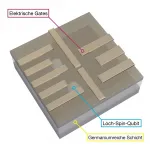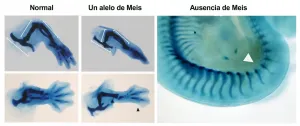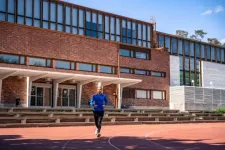(Press-News.org) Patients who, perhaps unbeknownst to their health care providers, are in need of genetic testing for rare undiagnosed diseases can be identified en masse based on routine information in electronic health records (EHRs), a research team reported today in the journal Nature Medicine.
Findings from the Vanderbilt University Medical Center study suggest that, among the patients of any sizeable health care system, there are hundreds or thousands with undiagnosed rare diseases of the sort where a genetic test could lead to a diagnosis.
"Patients with rare genetic diseases often face years of diagnostic odyssey before getting a genetic test, if they get one at all. Our work could contribute to a more systematic and timely approach, alerting providers of patients that might benefit from a genetic test," said the leader of the study, geneticist Douglas Ruderfer, PhD, associate professor of Medicine at VUMC.
It's estimated that more than 70% of rare diseases are genetic in origin. According to authors of the study, rare genetic diseases may look quite different from one patient to the next and may go undiagnosed even when well characterized in the medical literature.
Using routine EHR data to directly identify patients with specific genetic diseases is, for now, quite challenging: according to the study authors, the current state of knowledge about disease-causing genetic variation is too wanting, and the genetic resolution of current clinical tests is too low. Given this state of affairs, the team developed their predictive model to instead detect patients who fit historical criteria for testing in the eyes of clinicians.
To begin, the team developed a range of competing predictive algorithms. For training data, they used EHRs of patients for whom clinicians had ordered a type of genetic test called chromosomal microarray (1,818 cases), and similar patients whose records showed no history of genetic testing (7,326 matched controls). Across the training and test sets, the average age of the patients represented was 8.
"We were really aiming to build a model that captured and automated clinical suspicion of a genetic disease," said Theodore Morley, a staff data scientist who worked closely with Ruderfer on the study.
With all traces of genetic testing removed from a test set of 2,286 records, a machine learning algorithm emerged as the best performer, correctly classifying 87% of cases and 96% of controls.
Also showing high accuracy were independent validation efforts at Boston's Massachusetts General Hospital and again at VUMC, with far greater numbers of longstanding patients, cases now defined by evidence in the EHR of interaction with a genetics provider.
Importantly, the algorithm also performed well in identifying patients who received genetic tests other than chromosomal microarray.
The study supports the hypothesis that, within any EHR population, patients who are to be suspected of having rare genetic diseases are distinguishable via computation thanks to the presence of multiple rare signs and symptoms -- phenotypes, in the language of the study -- that are subject to documentation in the EHR. The team's predictive algorithms used EHR diagnosis codes exclusively (the same codes that drive health care billing), amalgamated for prediction purposes into so-called phenotype codes.
"After extensive validation demonstrated high predictive performance, we were really interested in assessing how an implementation of our model might compare to the current status quo for who receives a test, and what the results of those tests are," Ruderfer said.
From a set of 6,445 deidentified EHRs corresponding to genotyped patient specimens from BioVU, Vanderbilt's DNA biobank, the algorithm proved accurate in picking out individuals with pathogenic copy number variations, a type of genetic abnormality.
In collating this and other findings from the study, the authors estimate there are more than 2,000 patients at VUMC who have an unrecognized, potentially diagnostic copy number variation that could be identified with a genetic test.
Among close observers of the study is Josh Peterson, MD, MPH, director of VUMC's Center for Precision Medicine (where Ruderfer is an affiliated faculty member).
"The team's predictive model was shown to handily outperform current clinical performance, identifying patients who need testing more quickly and in greater numbers. Crucially, the model also proved portable to another health system. This paper's findings align very well with the push at VUMC to use data science to improve diagnosis of genomic syndromes," Peterson said.
INFORMATION:
Others on the study from VUMC include Lide Han, Nancy Cox, PhD, and Lisa Bastarache, MS. They were joined by researchers from Boston and Los Angeles. The study was supported in part by the National Institutes of Health (MH111776).
What The Study Did: Changes in pregnancy and birth rates before and after COVID-19 lockdown measures were estimated using electronic medical records.
Authors: Molly J. Stout, M.D., of the University of Michigan in Ann Arbor, is the corresponding author.
To access the embargoed study: Visit our For The Media website at this link https://media.jamanetwork.com/
(doi:10.1001/jamanetworkopen.2021.11621)
Editor's Note: Please see the article for additional information, including other authors, author contributions and affiliations, conflict of interest and financial disclosures, and funding and support.
INFORMATION:
Media advisory: The full study is linked to this news release.
Embed this link to provide your readers free access ...
Quantum computers with their promises of creating new materials and solving intractable mathematical problems are a dream of many physicists. Now, they are slowly approaching viable realizations in many laboratories all over the world. But there are still enormous challenges to master. A central one is the construction of stable quantum bits - the fundamental unit of quantum computation called qubit for short - that can be networked together.
In a study published in Nature Materials and led by Daniel Jirovec from the Katsaros group at IST Austria in close collaboration with researchers from the L-NESS Inter-university Centre in Como, Italy, scientists now have created a new and promising candidate system for reliable qubits.
Spinning Absence
The researchers created the qubit using the ...
Dogs may have earned the title "man's best friend" because of how good they are at interacting with people. Those social skills may be present shortly after birth rather than learned, a new study by University of Arizona researchers suggests.
Published today in the journal Current Biology, the study also finds that genetics may help explain why some dogs perform better than others on social tasks such as following pointing gestures.
"There was evidence that these sorts of social skills were present in adulthood, but here we find evidence that puppies - sort of like humans - are biologically prepared to interact in these social ways," said lead study author Emily Bray, a postdoctoral research associate in the UArizona School of Anthropology in the College of Social and Behavioral ...
(Toronto, June 3, 2021) -- The impact of deploying Artificial Intelligence (AI) for radiation cancer therapy in a real-world clinical setting has been tested by Princess Margaret researchers in a unique study involving physicians and their patients.
A team of researchers directly compared physician evaluations of radiation treatments generated by an AI machine learning (ML) algorithm to conventional radiation treatments generated by humans.
They found that in the majority of the 100 patients studied, treatments generated using ML were deemed to be clinically acceptable for patient treatments by physicians.
Overall, 89% of ML-generated treatments were considered clinically acceptable for treatments, ...
For reasons unknown, Earth's solid-iron inner core is growing faster on one side than the other, and it has been ever since it started to freeze out from molten iron more than half a billion years ago, according to a new study by seismologists at the University of California, Berkeley.
The faster growth under Indonesia's Banda Sea hasn't left the core lopsided. Gravity evenly distributes the new growth -- iron crystals that form as the molten iron cools -- to maintain a spherical inner core that grows in radius by an average of 1 millimeter per year.
But the enhanced growth on one side suggests that something in Earth's outer core or mantle under Indonesia is removing heat from the inner core at a faster rate than on the opposite side, under Brazil. Quicker cooling on one side would ...
Scientists at the Centro Nacional de Investigaciones Cardiovasculares (CNIC), working in partnership with researchers at the Institut de Recherches Cliniques de Montréal (IRCM) in Canada, have identified Meis transcription factors as essential biomolecules for the formation and antero-posterior patterning of the limbs during embryonic development.
In the study, published in Nature Communications, the research team carried out an in-depth characterization of the Meis family of transcription factors. Genetic deletion of all four family members showed that these proteins are essential for the formation of the limbs during embryonic development. "An embryo that develops in the absence of Meis does not ...
Regular strength and impact-type training may decrease or even prevent age-related bone deterioration in men, new research at the University of Jyväskylä, Finland, shows. The tibial bone properties of middle-aged and older male sprint athletes were followed over 10 years. The study presents novel findings on maintaining the adaptability of the aging skeleton and on the importance of regular intensive training for maintaining bone health.
"Part of the age-related bone loss is probably explained by reduced levels of physical activity. Especially intensive, bone-loading exercise ...
Affecting more than one in a hundred children, autism spectrum disorder is one of the most common neurodevelopmental disorders. It has a particular impact on social interaction, including difficulties in understanding other people's perspectives, beliefs, desires and emotions, known as 'theory of mind'. Bilingual families with an autistic child often tend - and are sometimes encouraged - to forego the use of one of the home languages, so as not to further complicate the development of their child's communicative skills. A researcher from the University of Geneva (UNIGE, Switzerland), in collaboration with the Universities ...
So-called quantum dots are a new class of materials with many applications. Quantum dots are realized by tiny semiconductor crystals with dimensions in the nanometre range. The optical and electrical properties can be controlled through the size of these crystals. As QLEDs, they are already on the market in the latest generations of TV flat screens, where they ensure particularly brilliant and high-resolution colour reproduction. However, quantum dots are not only used as "dyes", they are also used in solar cells or as semiconductor devices, right up to computational building blocks, the qubits, of a quantum computer.
Now, a team led by Dr. Annika Bande at HZB has extended the understanding of the interaction between several quantum dots with an ...
A biomarker in the blood of patients with bowel cancer may provide valuable insight into the risk of cancer relapse after surgery and the effectiveness of chemotherapy.
Research published in PLOS found circulating tumour DNA (ctDNA) measured before and after surgery provided a reliable marker for predicting whether the cancer would recur following chemotherapy treatment.
The ctDNA also provided a real-time measure of the effectiveness of chemotherapy, highlighting the potential for this test to provide an early indication of the success of chemotherapy in eradicating microscopic cancer.
At a glance
By measuring levels of ctDNA present in the blood of bowel cancer patients after surgery, researchers were able to predict the likelihood ...








